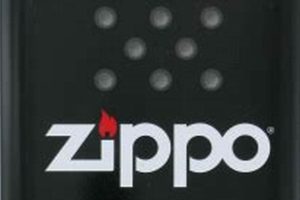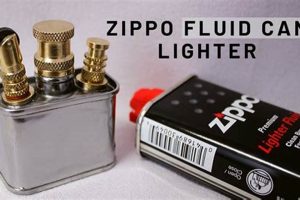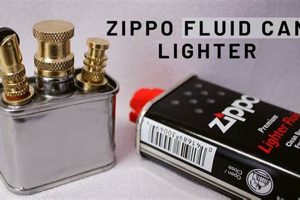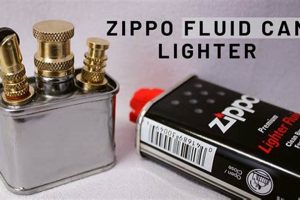Using charcoal lighter fluid in a Zippo lighter is generally discouraged. Zippo lighters are designed for optimal performance with Zippo’s own lighter fluid, a refined petroleum distillate. Charcoal lighter fluid, typically a heavier and less refined petroleum product, can leave gummy residues, clog the wick, and produce a sooty flame with an unpleasant odor. This can significantly impact the lighter’s functionality and lifespan.
The correct type of fuel is essential for maintaining a Zippo’s reliability and longevity. Using the recommended fluid ensures a clean, consistent flame and prevents damage to the internal components. While various lighter fluids exist, they are not all formulated equally. Choosing a fuel specifically designed for a Zippo lighter provides the best performance and safeguards the investment in the lighter itself.
The following sections will explore proper Zippo lighter maintenance, including the recommended fuel type and cleaning procedures. Additional information will cover troubleshooting common issues related to fuel and wick performance. Finally, the discussion will address safety precautions for handling and storing lighter fluid.
Tips for Proper Zippo Lighter Fuel Usage
Maintaining a Zippo lighter’s optimal performance requires careful attention to fuel selection and usage. The following tips offer guidance on maximizing lighter functionality and longevity.
Tip 1: Use Only Zippo Premium Lighter Fluid: This specialized fuel is formulated to burn cleanly and consistently in Zippo lighters, preventing clogging and residue buildup.
Tip 2: Avoid Charcoal Lighter Fluid: Heavier, less refined fuels like charcoal lighter fluid can damage the wick and internal mechanisms, leading to malfunctions and a shortened lifespan.
Tip 3: Fill the Lighter Correctly: Overfilling can lead to leaks and fuel evaporation. Fill the lighter until the felt packing material is saturated, but not overflowing.
Tip 4: Store Lighter Fluid Safely: Store lighter fluid in a cool, dry place away from open flames and heat sources. Keep it out of reach of children.
Tip 5: Clean the Lighter Regularly: Periodic cleaning, including wick replacement and flint wheel adjustments, ensures consistent performance and prevents fuel-related issues.
Tip 6: Address Leaks Promptly: If a leak is detected, empty the remaining fuel and allow the lighter to air dry completely before refilling. Persistent leaks may indicate a need for repair.
Tip 7: Dispose of Used Lighter Fluid Responsibly: Do not pour used lighter fluid down the drain. Consult local regulations for proper disposal methods.
Adhering to these guidelines ensures a reliable and long-lasting Zippo lighter experience. Proper fuel usage and maintenance are crucial for optimal performance and prevent potential damage.
This information provides a comprehensive understanding of fuel selection and maintenance for Zippo lighters. By following these recommendations, users can ensure their lighters function smoothly and reliably for years to come.
1. Fuel Type Incompatibility
Fuel type incompatibility lies at the heart of the question regarding the use of Kingsford lighter fluid in Zippo lighters. Zippo lighters are engineered for optimal performance with a specific type of fuel: a highly refined petroleum distillate. This fuel is carefully formulated to burn cleanly and consistently within the lighter’s mechanism. Kingsford lighter fluid, designed for starting charcoal fires, is a different type of petroleum producttypically less refined and heavier. This fundamental difference in fuel properties leads to significant compatibility issues.
The incompatibility manifests in several ways. The heavier Kingsford fluid struggles to travel up the Zippo’s wick effectively, leading to a weaker, less reliable flame. Furthermore, its less refined nature results in increased residue buildup within the lighter’s internal components. This buildup can clog the wick, hinder the flint wheel’s operation, and ultimately impair the lighter’s functionality. An example of this can be seen in the accumulation of gummy deposits within the chimney, restricting airflow and contributing to a sooty, inefficient burn. Another practical consequence is a shortened lifespan for the wick and other components due to the corrosive nature of the unsuitable fuel.
Understanding fuel type incompatibility is crucial for proper Zippo lighter maintenance. Utilizing the correct fuel ensures optimal performance and longevity. Attempting to substitute a different fuel type, such as Kingsford lighter fluid, introduces a range of potential problems, from inconsistent flames and unpleasant odors to permanent damage to the lighter. Ultimately, respecting the design specifications of the lighter by using the recommended fuel is essential for reliable and sustained operation.
2. Residue Buildup
Residue buildup represents a significant consequence of using Kingsford lighter fluid in a Zippo lighter. Kingsford lighter fluid, formulated for charcoal, contains heavier hydrocarbons and additives not present in Zippo’s recommended lighter fluid. These components do not burn as cleanly, leaving behind a sticky, tar-like residue. This residue accumulates on the wick, flint wheel, and internal surfaces of the lighter.
This buildup affects lighter functionality in several ways. The wick becomes clogged, restricting fuel flow and leading to a diminished flame or failure to ignite. The residue can also impede the smooth action of the flint wheel, making sparking less reliable. Furthermore, accumulated residue can obstruct the chimney, reducing airflow and causing an inefficient, sooty flame. Over time, this buildup can permanently damage the lighter, requiring extensive cleaning or even component replacement. A practical example of this is a user experiencing difficulty lighting their Zippo after using Kingsford fluid, followed by the discovery of a thick, gummy residue coating the inside of the lighter casing.
Understanding the direct link between using an unsuitable fuel like Kingsford and the resulting residue buildup is crucial for proper Zippo maintenance. Opting for the correct lighter fluid significantly mitigates this issue, ensuring consistent performance and extending the lighter’s lifespan. Regular cleaning can address minor residue accumulation, but preventing the problem altogether through proper fuel selection represents the most effective approach. This understanding underscores the importance of using the appropriate fuel to maintain a Zippo lighter’s functionality and longevity.
3. Clogged Wick
A clogged wick is a common consequence of using Kingsford lighter fluid in a Zippo lighter. The incompatibility between the heavier Kingsford fluid and the Zippo’s design leads to this issue. Kingsford lighter fluid, intended for charcoal, contains heavier hydrocarbons and additives not found in Zippo’s recommended fuel. These substances do not burn cleanly within the lighter’s mechanism, leaving behind a sticky residue that accumulates on the wick. This residue gradually obstructs the wick’s pores, hindering the capillary action necessary for drawing fuel to the flame.
The impact of a clogged wick is significant. Restricted fuel flow results in a weaker, inconsistent flame, often accompanied by increased difficulty in igniting the lighter. In extreme cases, the lighter may fail to light altogether. One can observe this effect by noting the blackened, hardened appearance of the wick and the reduced fuel absorption. The wick may also emit a strong, unpleasant odor due to the trapped residue. Furthermore, a clogged wick can shorten the lifespan of the lighter, necessitating more frequent wick replacements. For instance, a user accustomed to their Zippo lighting reliably might find it sputtering and producing a weak flame after using Kingsford fluid, a direct result of wick clogging.
Understanding the relationship between using Kingsford fluid and a clogged wick underscores the importance of using the correct fuel. Regularly inspecting and cleaning the wick, or replacing it when necessary, can mitigate some effects. However, preventing clogging through appropriate fuel selection offers the most effective long-term solution. This awareness contributes to maintaining the lighter’s functionality and maximizing its operational life, avoiding unnecessary maintenance and ensuring reliable performance.
4. Damaged Lighter
Damage to a Zippo lighter represents a significant risk associated with using Kingsford lighter fluid. This risk stems from the inherent incompatibility between the lighter’s design and the fluid’s chemical composition. Kingsford lighter fluid, formulated for charcoal ignition, possesses different properties than the refined petroleum distillate recommended for Zippo lighters. Its heavier consistency and higher residue content can lead to several detrimental effects on the lighter’s components. The accumulation of residue can clog the wick, hindering fuel flow and impacting the lighter’s ability to ignite. Furthermore, the heavier fluid can gum up the flint wheel mechanism, reducing sparking efficiency. Over time, these issues can escalate, potentially leading to permanent damage, requiring repair or replacement of parts.
Consider a scenario where a user consistently fills their Zippo lighter with Kingsford fluid. Initially, they might observe a decrease in flame intensity and reliability. As residue accumulates, the lighter becomes increasingly difficult to ignite, eventually failing to function altogether. Upon inspection, the wick might be found coated in a thick, gummy substance, the flint wheel mechanism jammed, and the interior of the lighter casing fouled with residue. This damage, directly resulting from the use of an incompatible fuel, necessitates extensive cleaning or even component replacement, impacting both the lighter’s functionality and its lifespan. Another example involves the corrosive nature of some charcoal lighter fluids, which can degrade the internal components of the lighter over time, leading to leaks or malfunctions.
The connection between using Kingsford lighter fluid and potential lighter damage underscores the importance of adhering to manufacturer recommendations. Using the correct fuel plays a critical role in preserving the lighter’s functionality and extending its operational life. While some damage might be reversible through thorough cleaning, repeated exposure to incompatible fuels can lead to irreversible damage, ultimately rendering the lighter unusable. This understanding reinforces the practical significance of selecting the appropriate fuel, highlighting its role in preventing damage and ensuring the long-term reliability of a Zippo lighter.
5. Safety Hazards
Safety hazards present a critical consideration when evaluating the use of Kingsford lighter fluid in a Zippo lighter. The inherent incompatibility between the fluid and the lighter’s design creates several potential risks. These risks arise from the fluid’s chemical properties, its behavior within the lighter’s mechanism, and the potential for unintended consequences.
- Uncontrolled Flames/Flare-Ups
Kingsford lighter fluid, designed for charcoal, burns differently than Zippo premium lighter fluid. Its higher volatility can lead to unpredictable flare-ups during ignition, posing a risk of burns or igniting nearby flammable materials. An example includes a sudden, larger-than-expected flame upon lighting the lighter, potentially catching loose clothing or hair on fire. This heightened risk underscores the importance of using the correct fuel for controlled, predictable flames.
- Fuel Leaks and Spillage
The heavier consistency of Kingsford lighter fluid can exacerbate the risk of leaks and spills. This can occur during filling or if the lighter is improperly sealed. Spilled lighter fluid presents a fire hazard and can also damage surfaces. Consider a scenario where a lighter filled with Kingsford fluid leaks inside a pocket, saturating clothing with flammable liquid. The risk of ignition and subsequent burns increases significantly. Using the appropriate fuel minimizes the risk of leaks due to its compatibility with the lighter’s seals and wick.
- Improper Combustion and Harmful Fumes
Using Kingsford lighter fluid in a Zippo can lead to incomplete combustion, producing sooty flames and potentially releasing harmful fumes. Inhaling these fumes can cause respiratory irritation or other health issues. Imagine a closed environment where a Zippo filled with Kingsford fluid is repeatedly used. The accumulation of fumes can create an unhealthy atmosphere, particularly for individuals sensitive to airborne irritants. Using the correct fuel ensures cleaner combustion, minimizing the release of harmful byproducts.
- Long-Term Health Risks
Repeated exposure to the fumes produced by burning Kingsford lighter fluid in a Zippo can pose long-term health risks. The incomplete combustion of the heavier hydrocarbons can release various potentially harmful substances. While infrequent use may not present significant immediate danger, prolonged exposure could contribute to respiratory problems or other health complications. This concern further emphasizes the importance of using the recommended fuel, minimizing exposure to potentially hazardous combustion byproducts.
These safety hazards underscore the inherent risks associated with using Kingsford lighter fluid in a Zippo lighter. Choosing the correct fuel significantly mitigates these risks, ensuring safe and reliable operation. Ignoring these safety considerations can lead to accidents, injuries, or long-term health issues, highlighting the practical and crucial importance of using the appropriate fuel. The potential consequences extend beyond mere lighter malfunction, encompassing serious safety implications that demand careful consideration.
Frequently Asked Questions
This section addresses common inquiries regarding the use of Kingsford lighter fluid in Zippo lighters.
Question 1: What happens if Kingsford lighter fluid is used in a Zippo lighter?
Using Kingsford lighter fluid can result in a clogged wick, residue buildup, a sooty flame, an unpleasant odor, and potentially damage the lighter’s internal components.
Question 2: Why is Zippo premium lighter fluid recommended?
Zippo premium lighter fluid is specifically formulated for optimal performance in Zippo lighters, ensuring a clean burn, consistent flame, and prolonged lighter life.
Question 3: Can any lighter fluid be used in a Zippo?
While other lighter fluids might seem similar, they are not all formulated equally. Using non-recommended fluids can lead to malfunctions and damage. Zippo premium lighter fluid is always recommended.
Question 4: How can one tell if the wrong lighter fluid has been used?
Indicators of incorrect lighter fluid use include a sooty flame, difficulty igniting, an unpleasant odor, excessive residue buildup, and a clogged wick.
Question 5: Is it safe to use charcoal lighter fluid in any type of lighter?
Charcoal lighter fluid is specifically designed for igniting charcoal and should not be used in lighters designed for refined lighter fluids. Always consult the manufacturer’s recommendations for the appropriate fuel type.
Question 6: What should be done if Kingsford lighter fluid has already been used in a Zippo?
If Kingsford fluid has been used, it’s recommended to drain the remaining fluid, clean the lighter thoroughly, replace the wick if necessary, and refill with Zippo premium lighter fluid.
Using the correct lighter fluid is crucial for maintaining a Zippo lighters functionality and longevity. Adhering to manufacturer recommendations ensures optimal performance and minimizes potential risks.
The next section provides step-by-step instructions for properly cleaning and maintaining a Zippo lighter.
Can I Use Kingsford Lighter Fluid in My Zippo? A Conclusion
Exploration of the query “can I use Kingsford lighter fluid in my Zippo?” reveals significant incompatibility between the fluid and the lighter’s design. Kingsford lighter fluid, formulated for charcoal ignition, possesses properties detrimental to a Zippo’s mechanism. Its heavier composition leads to residue buildup, clogging the wick and hindering fuel flow. This results in diminished flame, difficulty igniting, and potentially permanent damage to internal components. Furthermore, using an unsuitable fuel introduces safety hazards, including uncontrolled flames, fuel leaks, and the release of potentially harmful fumes. The analysis underscores the importance of using Zippo premium lighter fluid, specifically designed for optimal performance and longevity of these lighters.
Maintaining a Zippo lighter’s functionality and ensuring safe operation requires adherence to manufacturer recommendations. Using the correct fuel is paramount. Ignoring compatibility issues can lead to malfunctions, damage, and potential safety risks. Proper fuel selection, coupled with regular maintenance, preserves the lighter’s performance and extends its lifespan. Ultimately, respecting the design specifications contributes to a reliable and enjoyable user experience.







